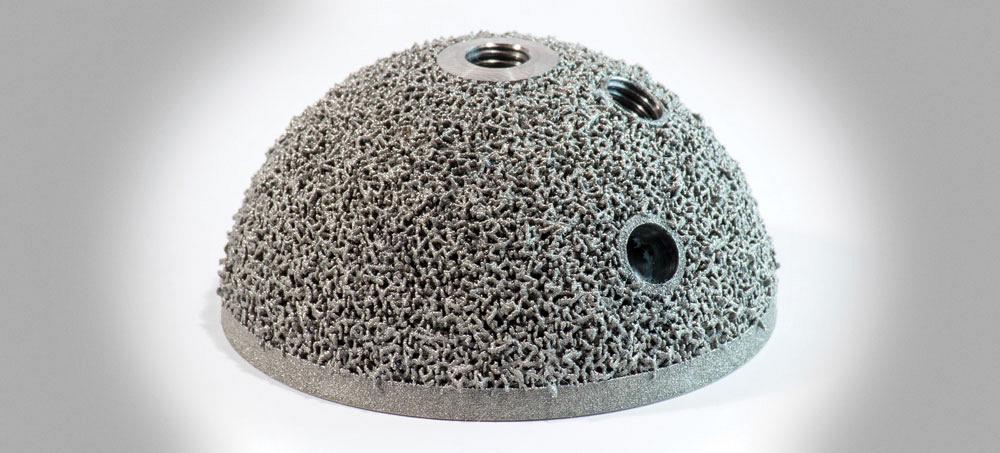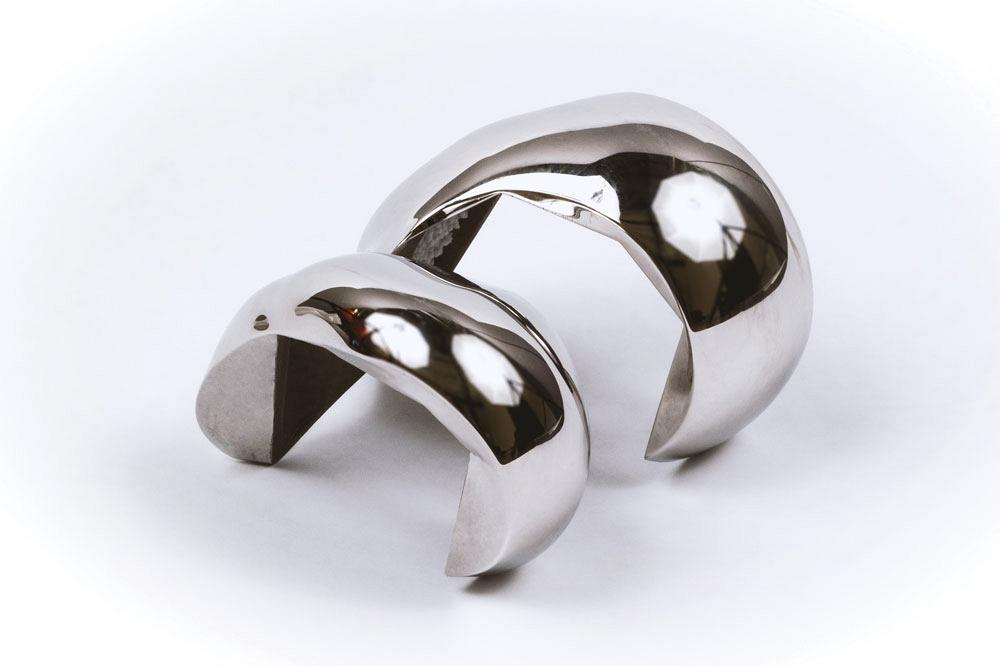- FMA
- The Fabricator
- FABTECH
- Canadian Metalworking
Titanium is king when it comes to implants
Materials used in medical and dental implants share the common traits of strength, corrosion resistance
- By Nate Hendley
- September 2, 2019
- Article
- Metalworking

Spine implants are just one of many parts created by Precision ADM, Winnipeg, for the medical sector. Photo courtesy Precision ADM.
The advanced machine shop (AMS) at Toronto’s Sunnybrook Research Institute (SRI) makes medical parts and products for surgeons.
Based on the seventh floor of the Sunnybrook Health Sciences Centre, AMS has produced a handful of titanium mesh implants for reconstructive surgery over the years. Implanted in a patient’s face to help bones regenerate, the mesh products were made using a 5-axis waterjet cutting machine.
“It was an interesting task, because when you’re cutting titanium with a waterjet, it literally looks like fireworks are going off because there’s sparks flying out when you cut it. It’s the only material we’ve come across where sparks [occur] when we’re cutting it with the waterjet cutter,” explained Michael Pozzobon, manager of AMS.
Once completed, the titanium mesh implants are passed on to the doctors who requested them for eventual use in reconstructive operations.
The 2,000-sq.-ft. AMS also includes a pair of industrial 3D printers, a CNC lathe, and a CNC mill. The focus at AMS is on research projects and prototypes, said Pozzobon.
Material must be biocompatible
The choice of titanium for the facial mesh implants was no accident. Titanium is the most popular material for medical and dental implants in Canada, said Dr. John E. Davies, professor at the Institute of Biomaterials and Biomedical Engineering and the Faculty of Dentistry, University of Toronto.
“In dentistry, commercially pure titanium, grade four [CP Ti] is the most common material. There are also titanium alloys that are used [for medical implants]. Historically, it has been a titanium 64 alloy. That’s the material of choice in the orthopaedics fields. There are other titanium alloys that are more esoteric and are not commercialized to any great extent. But commercially pure titanium and titanium 64 alloy are the most prominent,” said Davies.
Ti6Al4V (the official composition of the titanium alloy Davies is referring to) contains 6 per cent aluminum and 4 per cent vanadium. It is commonly used in replacement knee and hip joints and bone screws.
Precision ADM (PADM), a Winnipeg-based firm that makes aerospace and medical parts, is partial to Ti64ELI. This titanium light alloy offers excellent corrosion resistance and mechanical properties and is biocompatible, making it easier to be accepted by the human body after being implanted.
A couple of years ago, PADM successfully designed and manufactured a titanium hip cup using a combination of traditional and metal additive manufacturing methods.

A titanium hip cup was built using a combination of traditional and metal additive manufacturing methods. Photo courtesy of Precision ADM.
“Current customer projects include spine fusion devices, tibial trays, stainless steel instruments, and titanium medical screws,” said PADM Director of Sales and Marketing Derek VanDenDriessche. A tibial tray is part of a total knee replacement and is typically made from titanium.
Other materials PADM uses for medical products are cobalt chrome and 316L stainless steel. Production is split 60/40 between additive manufacturing and traditional manufacturing, which is done using four EOS M 290 machines that can 3D-print metal parts.
Why Ti?
So, why is titanium such a popular material for medical and dental implants?
“The answer is actually quite easy. Titanium is an oxygen-getter and it spontaneously forms protective oxide layers on its surface, which renders the bulk material significantly more corrosion-resistant than it would be with bare metal,” said Davies.
The human body has an average internal temperature of 37 degrees C and is similar to seawater in that it contains various potentially corrosive elements, he pointed out.
“It’s important when metals are put in the body that they can resist this rather aggressive environment,” he added.
According to the research paper “Biomaterials in Orthopaedics” in the Journal of the Royal Society Interface, in addition to being highly corrosive-resistant, titanium and its alloys are able to become tightly integrated into bone. This property significantly improves the long-term behaviour of the implanted devices, decreasing the risks of loosening and failure.
Titanium first became popular in the aerospace sector (where it was well-regarded for its toughness and hardness) before entering the medical/dental implant field. The first use of titanium and its alloys in these fields occurred in the 1940s.
Other contenders
Of course, titanium isn’t the only material used for implants.
A little over a decade ago, Micro Precision Parts Manufacturing (MPPM), a machine shop on Vancouver Island, garnered a great deal of attention when it produced an extremely small surgical aneurysm clip made out of silicon nitride ceramic. An aneurysm clip is placed inside the brain to prevent arteries from bleeding. The clip remains in place, affixed to the artery, following surgery. Manufacturing the clip involved micron-level tolerances and specialized tooling. Silicon nitride ceramic was chosen because of its biocompatibility and hardness, said Matthew Cotton, who runs MPPM with his father, Steve.

Precision ADM uses additive manufacturing to produce implants for knee surgery. Photos courtesy of Precision ADM.
The company mostly manufactures medical parts for external use but does make some implants.
“We primarily use various grades of stainless steels like 316, 303, and 416. It depends on the requirements from the medical companies for any given part. Some implants that we have made historically are from various grades of ceramic,” said Cotton.
Stainless steels have a good reputation when it comes to implants.
Stainless steels are corrosion-resistant because they have a high chromium content, which helps form a coating oxide. It’s the austenitic type of stainless steel that is the mostly widely used in this industry, however.
Stainless steels are commonly used for fracture plates, screws, and hip nails. Their use in joint replacement parts is rare because titanium and cobalt chrome alloys have better mechanical and corrosion-resistant properties.
Other common materials found in medical/dental implants are cobalt-chromium-molybdenum alloys, which are used for load-bearing components; hydroxyapatite-coated titanium found in hip and knee prostheses; and nickel-titanium pins and screws for spinal correctors.
Non-metallic materials used in this field include high-alumina ceramics, polypropylene, and polycarbonate. Surgical mesh, silicone, polyethylene, and 3D-bioprinted products are other potential materials for use in medical and dental implants.
Surgical mesh is created from both inorganic and biological materials, which are woven together. It is commonly used in hernia repair.
Industry experts are keeping a close watch on other materials that could become commonplace in the medical/dental implant field.
“I think one that needs to be mentioned is zirconia. That’s turning away from metallic materials into ceramics,” said Davies.

The advanced machine shop (AMS) and Toronto’s Sunnybrook Research Institute produces a waterjet to produce titanium mesh parts. Photo courtesy of AMS.
Zirconia is a strong, hard material that is used for making crowns and bridges in the dental field. It also fuses to bone well much like titanium. Zirconia is white in colour, an important property when it comes to dentistry.
“One of the problems in using metals in what’s called the smile zone or aesthetic zone is that there can be metal showing above the gum or the gum looks dark and black. But if the implant has been made of zirconia, it’s aesthetically more pleasing. Zirconia has become an important material in the dental field,” explained Davies.
It is doubtful zirconia will displace titanium any time soon, given the fact that more than 95 per cent of dental implants put in place today are made from titanium alloys. Still, it’s a certainty that new materials will come to the fore, maybe even replacing old materials in time.
Just as titanium is currently the go-to material for medical and dental implants, zirconia or other materials might become equally popular in the future.
Contributing writer Nate Hendley can be reached at nhendley@sympatico.ca.
Advanced Machine Shop, www.sunnybrook.ca
Micro Precision Parts Manufacturing, www.microprecisionparts.com
Precision ADM, www.precisionadm.com
University of Toronto, www.utoronto.ca
About the Author
subscribe now


Keep up to date with the latest news, events, and technology for all things metal from our pair of monthly magazines written specifically for Canadian manufacturers!
Start Your Free Subscription- Industry Events
ZEISS Quality Innovation Days 2024
- April 15 - 19, 2024
Tube 2024
- April 15 - 19, 2024
- Düsseldorf, Germany
Lincoln Electric's Large Format 3D Metal Printing Seminar
- April 16 - 17, 2024
- Cleveland, OH
CTMA Economic Uncertainty: Helping You Navigate Windsor Seminar
- April 30, 2024
- Windsor, ON Canada
MME Winnipeg
- April 30, 2024
- Winnipeg, ON Canada




















